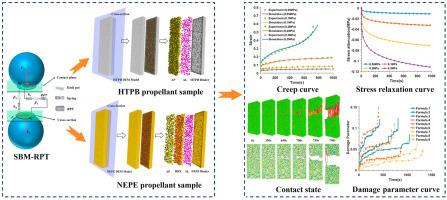基于离散元法的固体推进剂时间依赖行为及配方比较
IF 4.3
2区 材料科学
Q2 ENGINEERING, CHEMICAL
引用次数: 0
摘要
固体推进剂是一种由固体颗粒组成的高能复合材料,在长期储存过程中会表现出蠕变和应力松弛等随时间变化的行为。为了模拟和分析固体推进剂的时间依赖行为,在粒子流程序(PFC)中实现了基于速率过程理论(RPT)的修正软键模型(MSBM)。数值计算结果表明,MSBM预测的蠕变和应力松弛行为与实验数据吻合较好,表明MSBM可以准确地捕捉固体推进剂的时间相关行为。在此基础上,采用不同的粒度、体积分数和级配等公式生成了3类DEM样本,并构建了损伤参数来评估蠕变和应力松弛特征。在所有配方中,DEM模拟确定了损伤参数最小、抗蠕变和应力松弛性能最佳的分级配方。研究结果对固体推进剂的配方设计具有指导意义。本文章由计算机程序翻译,如有差异,请以英文原文为准。

Time dependent behaviors and formulation comparison of solid propellants based on discrete element method
Solid propellant is a high-energy composite material composed of solid particles, which can exhibit time dependent behaviors such as creep and stress relaxation during long-term storage. To model and analyze time dependent behavior of solid propellants, the modified soft-bond model (MSBM) based on the rate process theory (RPT) was implemented in Particle Flow Code (PFC). Numerical results show the predicted creep and stress relaxation behaviors by MSBM are in good agreement with experimental data, demonstrating that the MSBM can accurately capture time dependent behaviors in solid propellants. Furthermore, three categories of DEM samples were generated by varying formulations such as particle size, volume fraction and gradation, and a damage parameter was constructed to assess the characteristics of creep and stress relaxation. Among all formulations, the DEM simulation identified the graded formulation exhibiting the minimal damage parameter and optimal creep and stress relaxation resistance. These findings provide guidance for formula design of solid propellant.
求助全文
通过发布文献求助,成功后即可免费获取论文全文。
去求助
来源期刊

Particuology
工程技术-材料科学:综合
CiteScore
6.70
自引率
2.90%
发文量
1730
审稿时长
32 days
期刊介绍:
The word ‘particuology’ was coined to parallel the discipline for the science and technology of particles.
Particuology is an interdisciplinary journal that publishes frontier research articles and critical reviews on the discovery, formulation and engineering of particulate materials, processes and systems. It especially welcomes contributions utilising advanced theoretical, modelling and measurement methods to enable the discovery and creation of new particulate materials, and the manufacturing of functional particulate-based products, such as sensors.
Papers are handled by Thematic Editors who oversee contributions from specific subject fields. These fields are classified into: Particle Synthesis and Modification; Particle Characterization and Measurement; Granular Systems and Bulk Solids Technology; Fluidization and Particle-Fluid Systems; Aerosols; and Applications of Particle Technology.
Key topics concerning the creation and processing of particulates include:
-Modelling and simulation of particle formation, collective behaviour of particles and systems for particle production over a broad spectrum of length scales
-Mining of experimental data for particle synthesis and surface properties to facilitate the creation of new materials and processes
-Particle design and preparation including controlled response and sensing functionalities in formation, delivery systems and biological systems, etc.
-Experimental and computational methods for visualization and analysis of particulate system.
These topics are broadly relevant to the production of materials, pharmaceuticals and food, and to the conversion of energy resources to fuels and protection of the environment.
 求助内容:
求助内容: 应助结果提醒方式:
应助结果提醒方式:


